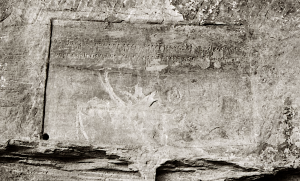First noticed (with text, translation and eye copy) in Cunningham 1854: 150-152. E. Thomas gives his own reading and a translation “approved of by Prof. Wilson” in Prinsep 1858: 246-247n4. Revised (with new facsimile) in ASIR 10: 50. First critical edition in Fleet 1888. Summarised in Trivedi 2001: 18 (No. 2). Discussed in: Willis 2009: 57-58. See also, Dvivedi 1947: no. 551; ARIE 1961-62: 175, no. 1718, App. C; and Pandey 1962: 79.
Cunningham (1854)
150-152
Cunningham, Alexander. (1854). The Bhilsa Topes; or, Buddhist Monuments of Central India: comprising A Brief Historical Sketch of the Rise, Progress, and Decline of Buddhism; with an account of the Opening and Examination of the Various Groups of Topes around Bhilsa. London / Bombay: Smith, Elder and Co. / Smith, Taylor and Co.
Prinsep (1858)
246-247
Prinsep, James. (1858). Essays on Indian Antiquities, Historic, Numismatic, and Palaeographic, of the late James Prinsep, F.R.S., Secretary to the Asiatic Society of Bengal, to which are added his Useful Tables Illustrative of Indian History, Chronology, Modern Coinage, Weight Measures, etc., edited, with notes, and additional matter, by Edward Thomas, Late of the Bengal Civil Service, Member of the Asiatic Society of Calcutta, London, and Paris. In Two Volumes - Vol. I. with numerous illustrations. Edited by Edward Thomas. London: John Murray.
ASIR 10 (1880)
50
Cunningham, Alexander. (1880). Report of Tours in Bundelkhand and Malwa in 1874-75 and 1876-77 (Archaeological Survey of India Reports 10). Calcutta: Superintendent of Government Printing.
Fleet (1888)
21-25, no. 3
Fleet, J. F. (1888). Inscriptions of the Early Gupta Kings and Their Successors. Calcutta: Superintendent of Government Printing.
Bhandarkar (1929)
171, no. 1260
Bhandarkar, Devadatta Ramakrishna. (1929). A List of the Inscriptions of Northern India in Brahmi and its derivative Scripts, from about 200 A. C. (Appendix to Epigraphia Indica volumes XIX to XXIII). Calcutta: University of Calcutta.
Dvivedi (1947)
no. 551
Dvivedi, Harihar Nivas. (1947). Gvāliyara Rājya ke abhilekha. Gvāliyara: Madhya Bhārata Purātatva Vibhāga.
ARIE (1961-62)
175, no. 1718, App. C
Narasimhaswami, H. K. (ed.) (1966). Annual Report on Indian Epigraphy for 1961-62. Calcutta: Government of India Press.
Pandey (1962)
79
Pandey, Raj Bali. (1962). Historical and Literary Inscriptions (The Chowkhamba Sanskrit Studies, 23). Varanasi: Chowkhamba Sanskrit Series Office.
Sircar (1965)
(vol. 1) 279-280, bk. III, no. 10
Sircar, Dines Chandra. (1965). Select Inscriptions Bearing on Indian History and Civilization. Volume I: From the Sixth Century B.C. to the Sixth Century A.D. (Second Edition). Calcutta: University of Calcutta.
Bhandarka (1981)
242-244, no. 7
Fleet, J. F., and Bhandarkar, D. R. (1981). Inscriptions of the Early Gupta Kings (Revised Edition). Edited by Bahadur Chand Chhabra and Govind Swamirao Gai. New Delhi: Archaeological Survey of India.
Agrawala (1983)
no. 10
Agrawala, Prithvi Kumar. (1983). Imperial Gupta Epigraphs (गुप्ताधिराजलेखमण्डल). Ancient Indian Epigraphical Sources (प्रत्नाभिलेखसंहिता) X.1. Varanasi: Books Asia.
Goyal (1993)
106-108
Goyal, Shri Ram. (1993). गुप्तकालीन अभिलेख/Guptakālīna Abhilekha (Inscriptions of the Gupta Age). Jodhpur: Kusumanjali Prakashan.
Trivedi (2001)
18
Trivedi, Harihar Vitthal. (2001). Epigraphs of Madhya Pradesh. New Delhi: Director General, Archaeological Survey of India.
Willis (2009)
57-58
Willis, Michael D. (2009 [digitally corrected edition 2019]). The Archaeology of Hindu Ritual: Temples and the Establishment of the Gods. Cambridge: University Press.
